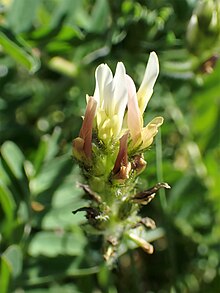| Astragalus boeticus | |
|---|---|

| |
| Scientific classification | |
| Kingdom: | Plantae |
| Clade: | Tracheophytes |
| Clade: | Angiosperms |
| Clade: | Eudicots |
| Clade: | Rosids |
| Order: | Fabales |
| Family: | Fabaceae |
| Subfamily: | Faboideae |
| Genus: | Astragalus |
| Species: | A. boeticus |
| Binomial name | |
| Astragalus boeticus L. | |
| Synonyms | |
|
Astragalus baeticus | |
Astragalus boeticus, the yellow milk vetch, or Swedish coffee is a species of annual herb in the family Fabaceae. It is native to the Mediterranean and the Middle East.
Description
They have a self-supporting growth form and compound, broad leaves.
They can grow to 0.6 meters (2 feet). The bloom period is between the months of July to August. The plant has both male and female organs. It can fix nitrogen. It is pollinated by Bees, Moths, and Butterflies.
It is most commonly found in March and April. It is most commonly found in the country of Spain, being found more than 500 times there.
Distribution
It can be found in the countries and islands of Albania, Algeria, The Baleares, The Canary Islands, Corsica, Cyprus, East Aegean Islands, Egypt, France, Greece, Iran, Italy, Kriti, Lebanon-Syria, Libya, Madeira, Morocco, Palestine, Portugal, Sardegna, Sicilia, Sinai, Spain, Tunisia, Turkey, Western Sahara, and ex-Yugoslavia.
Uses
The seed pods are edible. Roasted seeds are used as a substitute of coffee.
It has been used as a coffee substitute, especially during the 1800s, when coffee was scarce. It was even used by the Swedish monarchy. There is evidence that Astragalus boeticus has a lot of genetic diversity, as it is found in most of the Mediterranean and parts of the Middle East. Evidence suggests with limited breeding that it could be a better coffee substitute.
Sources
[REDACTED] This article incorporates text from a free content work. Licensed under CC0 (license statement/permission). Text taken from Astragalus boeticus. Encyclopedia of Life.
References
- ^ "Astragalus boeticus L." www.gbif.org. Retrieved 2023-08-01.
- "Astragalus boeticus L. - Encyclopedia of Life". eol.org. Retrieved 2022-02-04.
- Mifsud, Stephen (2002-08-23). "Asplenium sagittatum (Mule's Fern) : MaltaWildPlants.com - the online Flora of the Maltese Islands". www.maltawildplants.com. Retrieved 2022-02-07.
- ^ "Astragalus boeticus Swedish Coffee PFAF Plant Database". pfaf.org. Retrieved 2023-08-01.
- "Astragalus boeticus L. | Plants of the World Online | Kew Science". Plants of the World Online. Retrieved 2023-08-01.
- Prohens, Jaime; Andújar, Isabel; Vilanova, Santiago; Plazas, Mariola; Gramazio, Pietro; Prohens, Rafael; Herraiz, Francisco J.; De Ron, Antonio M. (2014-01-01). "Swedish coffee (Astragalus boeticus L.), a neglected coffee substitute with a past and a potential future". Genetic Resources and Crop Evolution. 61 (1): 287–297. doi:10.1007/s10722-013-0059-0. hdl:10251/64447. ISSN 1573-5109.
External links
- [REDACTED] Media related to Astragalus boeticus at Wikimedia Commons
- [REDACTED] Data related to Astragalus boeticus at Wikispecies
- "Astragalus boeticus". Plants for a Future.
| Taxon identifiers | |
|---|---|
| Astragalus boeticus |
|
| This article needs additional or more specific categories. Please help out by adding categories to it so that it can be listed with similar articles. (February 2022) |
This Astragalus-related article is a stub. You can help Misplaced Pages by expanding it. |